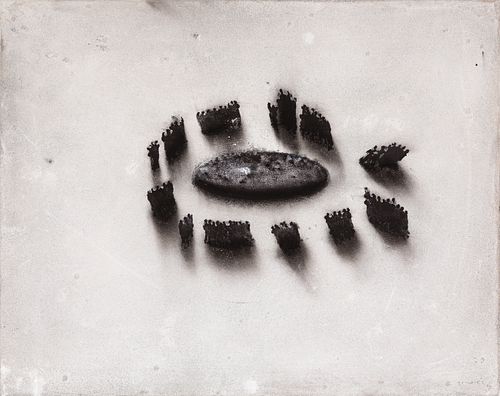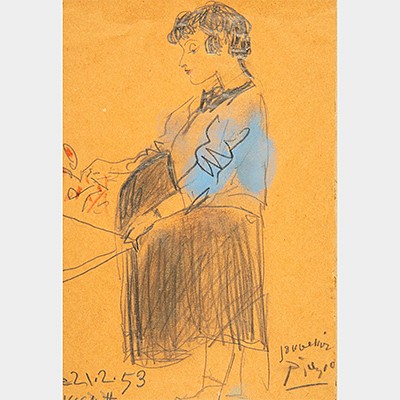JUAN GENOVÉS (Valencia, 1930 - Madrid, 2020). "Reseña 6", 1996. Oil on canvas. With label on the back of the Marlborough Gallery, New York. Signed and
Lot 90
About Seller
Setdart Auction House
Carrer Aragó 346
Barcelona
Spain
Setdart Subastas was born in 2004 and is currently the first online art auction in Spain with solidity, prestige and reliability guaranteed by our more than 60,000 users. Setdart has a young, dynamic and enterprising team ready to successfully manage the purchase and sale of art works through custom...Read more
Estimate:
EUR€9,000 - EUR€10,000
$9,375 - $10,416.67
Absentee vs Live bid
Two ways to bid:
- Leave a max absentee bid and the platform will bid on your behalf up to your maximum bid during the live auction.
- Bid live during the auction and your bids will be submitted real-time to the auctioneer.
Bid Increments
| Price | Bid Increment |
|---|---|
| EUR€0 | EUR€10 |
| EUR€200 | EUR€25 |
| EUR€500 | EUR€50 |
| EUR€1,000 | EUR€100 |
| EUR€3,000 | EUR€200 |
| EUR€5,000 | EUR€500 |
| EUR€10,000 | EUR€1,000 |
| EUR€20,000 | EUR€2,000 |
| EUR€50,000 | EUR€5,000 |
About Auction
By Setdart Auction House
Sep 20, 2021
Set Reminder
2021-09-20 08:00:00
2021-09-20 08:00:00
America/New_York
Bidsquare
Bidsquare : CONTEMPORARY ART
https://www.bidsquare.com/auctions/setdart-auction-house/contemporary-art-7482
Setdart Auction House sofia@setdart.com
Setdart Auction House sofia@setdart.com
- Lot Description
JUAN GENOVÉS (Valencia, 1930 - Madrid, 2020). "Reseña 6", 1996. Oil on canvas. With label on the back of the Marlborough Gallery, New York. Signed and dated in the lower right corner. Size: 33 x 41 cm; 37 x 45 cm (frame). In the 90's Genovés worked on this type of composition without any elements of colour, simply with the contrast between black and white. He set up scenes through elements arranged in a circular composition. In many of these works the human figure can be seen, in a certain way distorted, however in this particular case the distortion goes much further, so that only the shape itself can be seen, without any details. In such a way that the viewer approaches totemic structures such as Stonehenge. One of the main exponents of the social-critical realism of the fifties, Juan Genovés trained at the Valencia School of Fine Arts and in 1955 he made his first trip to Paris. Over time his art would evolve along the lines of existentialism. A founding member of various groups, such as Los Siete, Parpalló and Hondo, after his 1965 exhibition at the Biblioteca Nacional, his so-called "political realism" made him a committed defender of freedom. His vision makes him truly unique; the human figure is always the protagonist, both in its presence and its absence and even in its shadows, in which all the dreamlike charge of existential anguish resides. Genovés starts from a photographic approach, looking for a constant transformation of the perspective of the motif, of the point of view. With this change of perspective the author brings us closer to or further away from the scene, looking for the movement of the masses guided by the collective, working class intelligence that gives transcendence to the meaninglessness of the individual experience and makes evident the loneliness, manipulation and injustice that human beings are exposed to. The artist criticises the mass culture that fosters competitiveness, consumerism, individuality and the loss of social values. Expressive in his use of pictorial formats and materials in contrast to the forcefulness of his subject matter, Genovés is symbolist in his composition and rhythms. In his work he constantly questions the freedom of man in today's society as well as his own freedom within his own production. More well known abroad than in our country, he has participated in numerous biennials such as the Hispano-American Biennials in Havana and Barcelona, the Paris Biennial and the World's Fair in New York. In 1994 the IVAM dedicated an important retrospective exhibition to him. He has had solo exhibitions all over Spain as well as in Puerto Rico, Rio de Janeiro, Lisbon, Rome, New York, Tokyo, Turin, Berlin, Montreal, Zurich, Bogota and Paris. Juan Genovés is present in the IVAM in Valencia, the Museo Nacional Centro de Arte Reina Sofía, the Juan March Foundation, the Centre National d'Art Contemporain in Paris, the MOMA in New York and the La Caixa, Argentaria and Thyssen-Bornemisza collections.
- Shipping Info
-
In-house shipping available. Please inquire at admin@setdart.com.
-
- Buyer's Premium



 EUR
EUR CAD
CAD AUD
AUD GBP
GBP MXN
MXN HKD
HKD CNY
CNY MYR
MYR SEK
SEK SGD
SGD CHF
CHF THB
THB
















